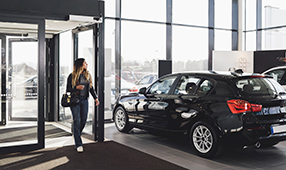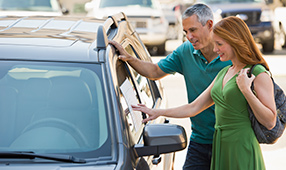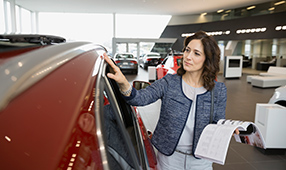Key takeaways
- Even in a car-buying emergency, make time for research.
- Consider renting a car so you have the time you need to make a calm, informed decision.
- Read about cars you like, features you may want and determine what you can afford before you go to a car dealership.
- Get help buying a car through the NEA Auto Buying Program, a car-buying service for NEA members.
What would you do if you suddenly had to replace your car?
If your car is totaled in an accident or a sudden repair bill ends up costing more than the car is worth, you’ll unexpectedly be in the market for a new, or new-to-you, car.
Danny Kofke, author of The Wealthy Teacher: Lessons for Prospering on a School Teacher’s Salary, knew the mileage was getting high on the car he’d been driving since 2002 but hoped to keep the car until it died.
His old car did just that in January, 2019, while Kofke was driving to work. “It was a little scary, just completely dying on the side of the road,” Kofke says, but the Georgia-based special education teacher managed to get the bucking car off the road and into a parking lot before it shut off completely.
“We had school that day,” Kofke says, “and then my wife (also a teacher) came and picked me up and we went straight to a car dealership.” He read Consumer Reports regularly so he already had a good idea what to buy. He chose a Kia knowing has a good warranty according to Consumer Reports and says, “I’ve been very happy with it so far.”
While we discourage buying a car in a hurry, sometimes it’s simply unavoidable. But it’s still important to do the research that will lead to a car that will serve you—and your budget—well for years to come.
Here are essential steps and resources that can help get you through the car-buying process quickly.
1. If you can afford to do so, rent a car to buy yourself valuable research time. If your car is totaled and your auto insurance includes rental car reimbursement, use it. “Rely on that for as long as you can so you can do as much research as possible,” says Jon Linkov, Consumer Reports deputy cars editor.
Even if you have to pay out of pocket, rent a small car—smaller cars cost less—that you can use to shop and compare cars for a couple of days, suggests Linkov. Investing in a rental can be expensive, Linkov notes, “but buying the wrong car is a long-term cost that you don’t want to shoulder.” As an NEA member, you can rent a car at a discount through the NEA Travel Program.
2. Determine your budget. Even though you’re in a hurry, take the time to figure out what you can realistically spend. Read Understanding the Total Cost of Car Ownership to make sure you include all the costs. You can also use Edmunds.com’s guide How Much Car Can I Afford to help you set a realistic budget.
3. Get your financing in order. First, check your credit score if you don’t know it. Many banks now allow you to access your score for free, but if yours does not, you can use sites such as Credit Karma and NerdWallet to get your score. The higher your score, the lower the interest rate could be on your loan.
While it’s tempting to go with the flow—especially when there’s a time crunch—and get financing through a dealership, take the time and check with your bank or credit union along with other lenders. You can compare your findings to what the dealership may offer you. Credit Karma does a good job at explaining the loan process in more detail.
4. Pick several vehicles that might interest you. You may already have a gut feeling for what you want. Do you want the same make and model vehicle that you just had to give up? Or, knowing your car was getting older, had you already started eyeing certain brands? If not, and you need a starting point, read the Edmunds.com article 10 Steps to finding the Right Car for You for tips that can help you narrow the field.
5. Research online. Car review and research sites such as Kelley Blue Book (KBB.com) and Edmunds (Edmunds.com) offer loads of information and tools to help.
“A couple hours spent one evening can really put you ahead of going into the process ‘naked,’” says Linkov. Consumer Reports has reviews and guides about cars, tires, safety features, whether to buy used or new and much more, including CR’s annual Car Buying Guide. You can access these features with a digital subscription of $10/month. If you already have a print subscription you can upgrade to digital access for $25/year. (And as an NEA member you can get a discount on a print subscription through the NEA Magazine Service.)
You can also use research tools through the NEA Auto Buying Program and take advantage of savings opportunities available only to NEA members. This car buying service, in partnership with TrueCar, gives you access to upfront pricing information, thousands of dollars in savings off MSRP and many other perks.
“TrueCar features excellent information on vehicle features, specs and stats such as dimensions and fuel economy to help you narrow down your choice,” says Alain Nana-Sinkam, vice president of strategic initiatives at TrueCar.
And when you’ve chosen a vehicle you’re interested in, you’ll get “pricing context,” which Nana-Sinkam explains as “a view of what others are paying for the same kind of vehicle in your area.” TrueCar will “introduce you [to] dealers who have the vehicle you’re looking for in stock, and those dealers will give you up-front price offers,” Nana-Sinkam adds. You’ll save time and won’t need to negotiate.
6. Schedule test drives to get a feel for the cars you’ve chosen. Even in a rush, you still need to see prospective cars in person and test drive them, says Ronald Montoya, senior consumer advice editor for Edmunds.com car shopping site. The time you invest helps you make a smarter decision.
Use the research you’ve done to narrow your choices, then pick a day to schedule a few test drives at dealerships that have the cars you’re interested in, Montoya advises. “Give yourself a couple of hours at each dealership,” he suggests. “Call ahead so they can pull the vehicle [you want to test] out and have it ready when you arrive.”
A test drive helps you determine if a car feels good to drive, has good visibility, has controls that are easy to understand and has the features you want. You can also see if the car has picked up any dings or scratches on the dealer’s lot.
“The idea of doing these roughly back-to-back is that you can really start to feel the differences between cars,” Montoya says. Comparing is easier when information is fresh in your mind.
Bonus: Scheduling several test drives on the same day also gives you a negotiating tool, Montoya notes. If a dealer edges into heavier negotiations, you can cut to the chase by saying, “I have an appointment and have to go to the next dealership so just give me the pricing information or email it to me and we’ll be in touch later.”
7. Buy your car! At this point you may be ready to buy. You’ve figured out your budget, learned about loans, done your research, picked a few possibilities and scheduled test drives. If you want to buy your car on your own from one of the dealerships you’ve checked out, learn how to become a better car buyer with these negotiating tips. Or you can skip the hassle and buy your car through the NEA Auto Buying Program. Congratulations on your new ride!
Don’t rush into a deal: One educator’s story. When Rhode Island educator Dawn Casey-Rowe ruptured her Achilles’ tendon right before student teaching, she couldn’t drive her car because it was a manual stick shift.
“I needed an automatic overnight,” says Casey-Rowe, author of A Broke Teacher’s Guide to Success, “so I traded in my car for a lease since my credit was stretched in grad school. Leasing isn’t a great financial deal, but on a day’s notice, I couldn’t sell my car on the open market and didn’t have anyone to trade with for a couple of months either,” she explains.
“This set me back considerably,” Casey-Rowe says. “It’s best to buy a car and drive it past the value point—where it’s still good, but it’s paid off—and then save for the next car, but I flipped a newer car for a bad financial deal—a double whammy.”
It would have been a devastating blow because Casey-Rowe was working weekends in Connecticut. Getting there and back took 10 hours of driving a week which was well over her lease mileage limit.
“That would’ve meant thousands in mileage penalties,” Casey-Rowe says, but she dodged that financial disaster when her dealer offered a rare promo: “Turn in your lease for a new car and we’ll waive the penalties.” She doesn’t recommend this tactic but says in this case, “it saved my financial life. I was able to go into that new car, and then after driving it for a while, I traded it in for a used car I liked.”
The experience taught Casey-Rowe that “taking a day or two to do research could save you thousands and is well worth the pause. Even if you’re busy, block off a full day or weekend to nail down a good car purchase. Time spent up front pays on the back end,” she says. “You can save time by shopping online and calling in first” and by knowing—and using—reliable dealers in your area.












